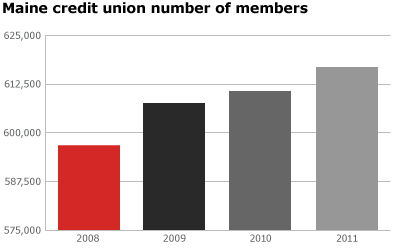Marketing and big-bank backlash swell credit union ranks
Maine's credit unions have seen a 3.4% rise in membership over the last four years, with assets up by 19.5%, reflecting a national trend that has seen credit union membership rise as marketing efforts increase and consumers become increasingly disenfranchised with larger financial institutions.
Nationwide, credit union assets saw a 5% bump in 2011 with total assets across the country's 7,094 federally insured credit unions rising to $47.4 billion according to National Credit Union Administration
Around the country, credit unions hit a record number of members last year, adding 1.3 million in 2011. Much of the growth on the national level came in the fourth quarter with 398,000 customers leaving larger financial institutions for smaller community banks and nonprofit credit unions.
The trend was a bit more subdued in Maine, where credit union membership has long been above average; at 46.6%, Maine ranks sixth in credit union membership as a percentage of state population, while nationwide the average is 29.8%.
“Maine has always been a very strong credit union state in general. I've always said they are one of the best kept secrets in the world of financial services,” says John Murphy, president and CEO of the Maine Credit Union League. The MCUL's youth-oriented Young & Free program, surcharge-free ATMs, increased marketing budgets and recent news stories presenting credit unions as a financial services alternative have all contributed to the recent growth in membership and assets, according to Murphy.
Four-year growth figures for Maine credit unions also show growth in loans and savings across the state's 191 credit union branches with loans rising 9.4% and savings up 21.5%.
Originally founded as a cooperative movement aimed at pooling money to offer credit to individuals, the first official credit unions were founded in Germany in 1849 to protect poor urban workers from opportunistic loan sharks. The concept grew rapidly in the United States during the Great Depression, when President Franklin D. Roosevelt signed the Federal Credit Union Act, establishing a nationwide credit union system overseen by the federal government.
“The Great Depression is really when credit unions started to spread around the country to serve people of all incomes and backgrounds,” says Murphy. Given the hardscrabble roots of the credit union model, the recent rise in membership could well be tied to the recent economic downturn, according to Murphy. “In tough economic times, people look to save money on a bunch of things — that holds true for financial services as well.”
Credit unions typically offer lower late-payment, overdraft and ATM fees as well as interest rates than their banking brethren; five-year car loans at banks carried an average interest rate of 5.1% last September while credit unions were 3.7%, according to CNNMoney. The Credit Union National Association estimates credit union members saved $6.78 billion in interest and fees from 2010 to 2011 as compared with banking institutions.
“You can't be in financial services today and not have some sort of fee structure, but the issue is to what degree do you implement and impose fees,” says Murphy.
Murphy says the nonprofit, member-run credit union model promotes accountability and fosters a sense of community within the organization. “There is certainly a difference in terms of structure versus [big banks]. Credit unions are responsible to membership as the people that own and operate the [credit union] are also the people that use it,” says Murphy.
The cooperative credit union model held up particularly well during the recession, according to CUNA. With volunteer boards and no enterprising stockholders to answer to, credit unions were able to avoid the danger-laden derivatives market that put many larger financial institutions on shaky financial footing and focus more on serving their local communities.
“With credit union loans, all those dollars have gone directly back into the community, whether it's a home mortgage or car loan, it goes right back into the local economy,” says Murphy.
Remember, remember the fifth of November
Last November's Bank Transfer Day capitalized on consumer discontent surrounding increased service fees on checking accounts at large national banks such as Wells Fargo, Citi and Chase, but it was a proposed monthly fee for debit card use at Bank of America that catalyzed the effort, leading one California woman to create a Facebook event urging friends to withdraw their money from “big banks” on Nov. 5.
Within three days, Kristen Christian's event had garnered 8,000 attendees. Two days before Bank Transfer day, that number swelled to nearly 80,000. CUNA estimates that 40,000 new credit union accounts were opened on Bank Transfer Day.
In the three months following, an estimated 5.6 million Americans moved some or all of their money from banks to credit unions, according to Javelin Strategy & Research. Eleven percent of those who transferred funds cited Bank Transfer Day as the reason for the switch, while 26% attributed the decision to increasing banking fees.
While Bank of America eventually scrapped the new fee for debit card use, the country's second largest bank still saw a 20% increase in account closures in the fourth quarter of 2011, while credit unions added 1.3 million new members to bring total membership to a record 91.8 million, according to the National Credit Union Administration.
“Bank Transfer Day was not started by the credit union industry but rather a consumer who was fed up,” says Murphy, who doesn't discount the role of social media in effecting change. “When these sorts of things happen today, they are more apt to be promoted virally.”
Overall, defection rates for large, national and midsize banks rose an average of 2.1% while defection rates for credit unions dropped 7.9%.
While Murphy could not provide any data on the effect of Bank Transfer Day on credit union membership in Maine, he said the media hype surrounding the event frequently mentioned credit unions as a “good, viable alternative” to larger financial institutions. “I'm sure there has been some rise,” Murphy says.
Chris Pinkham, president of the Maine Bankers Association, takes issue with the recent surge in anti-bank media that lumps all such institutions together regardless of size, service or community involvement. “The average person just looks at the headlines. The analogy I use is Congress — when polled, everyone says they dislike Congress, but when you ask them about their individual senator, they love them,” says Pinkham, whose organization represents 30 Maine-based banks, the overwhelming majority small, community banks.
But credit unions aren't just counting on organic growth, having launched a marketing effort to lure young Mainers to the state's credit unions. “Certainly credit unions are advertising more and individual marketing efforts have increased,” says Murphy.
A youthful face of credit unions
A credit union member since the age of 6, Seth Poplaski never needed to be sold on the merits of small, community-based banking.
But as discontent with big banks started to rise following the TARP bailout in 2008, Poplaski started to notice a growing ire among his college-age peers. TARP saw the federal government shell out upwards of $430 billion to purchase assets and equity from financial institutions as a means of strengthening the faltering economy. The taxpayer share of the TARP program is estimated by the Congressional Budget Office to be $19 billion.
“People really started to get fed up with a lot of what banks stood for and after the bailout, I think they kind of started looking at credit unions more and more,” says Poplaski, who will soon end his one-year tenure as spokesperson for the Maine Credit Union's Young & Free program. Through the initiative, Poplaski reaches out to Mainers ages 18 to 25, educating them on the benefits of credit union membership while helping to build a sense of community that he says is central to the credit union ethos.
The program's Free for Me checking account is tailor-made for younger members with fewer fees, built-in safeguards and modern amenities like no minimum balance, no monthly fees, online banking, shared branching and the “Oops Refund” to protect members who overdraw on their account. Over 2,000 such accounts were opened by 18- to 25-year-old Mainers in the last year, according to Poplaski, who partially credits awareness from movements like Occupy Wall Street and Bank Transfer Day to the surge. “[Those] definitely helped us out,” he says.
A University of Maine grad with a focus in public management and broadcast journalism, Poplaski was intrigued by a job posting he saw at his local Bangor Federal Credit Union branch seeking a spokesperson for a new youth-targeted program being organized by the state's credit unions.
Working as a bartender at the time, Poplaski was eager to hone his media and public relations chops while promoting a system he had long believed in and dispelling misconceptions among his peers. “People really lump credit unions and banks together. Credit unions might offer some of the same services, but they're not the same thing,” Poplaski says.
Poplaski found that among his peers, familiarity and brand names could outweigh logic and cost when it came to choosing a financial institution. “If you see a Bank of America, you know what you're going to get. People think banks are more convenient and they don't really look into it — it's like eating at a McDonalds or Subway because you know what you're going to get,” says Poplaski.
Two blog posts, videos and an interview later, Poplaski made the final cut and stepped into his role as spokesperson last spring. At 24, Poplaski represents the older end of the 18-to-25 spectrum courted by the Young & Free program when he applied, but says his age affords him a good perspective on the issues facing post-college youth. “I had the experience of being in college, paying off loans and living on my own so I can say ‘I've gone through this, I understand it',” Poplaski says.
Dollars and cents aside, Poplaski says that credit unions offer a sense of community that one doesn't typically see in the financial sector, an ethos he likens to that of his favorite sports team. “I'm a huge Green Bay Packers fan, and they are also owned by the fans, so I kind of liken it to that — you put money in credit union and you're a member, not a customer. You have a have a say at the annual meeting, you have a voice,” Poplaski says.
But Pinkham sees the unique tax status afforded to credit unions as undermining their purported ethos of community involvement. Under federal law, credit unions are not required to pay federal or state income taxes because, as not-for-profit entities, credit unions return all profits to members in the form of lower rates and fees. Credit unions are still responsible for payroll, property and sales tax as well as various licensing fees.
“Credit unions have expanded their membership from a small, narrow common bond of members in the days of parish or company-based credit unions, but they still have the huge advantage of paying no state or federal taxes,” says Pinkham. “Of course it's easier to offer less expensive, more attractive rates when you don't pay taxes.”
Murphy says the Young & Free program is an important service as credit unions attempt to reach out to the next generation. “This [program] is a great opportunity to do that,” he says. Having secured funds to keep the program running for another year, the search for the next Young & Free spokesperson began in March.













Comments